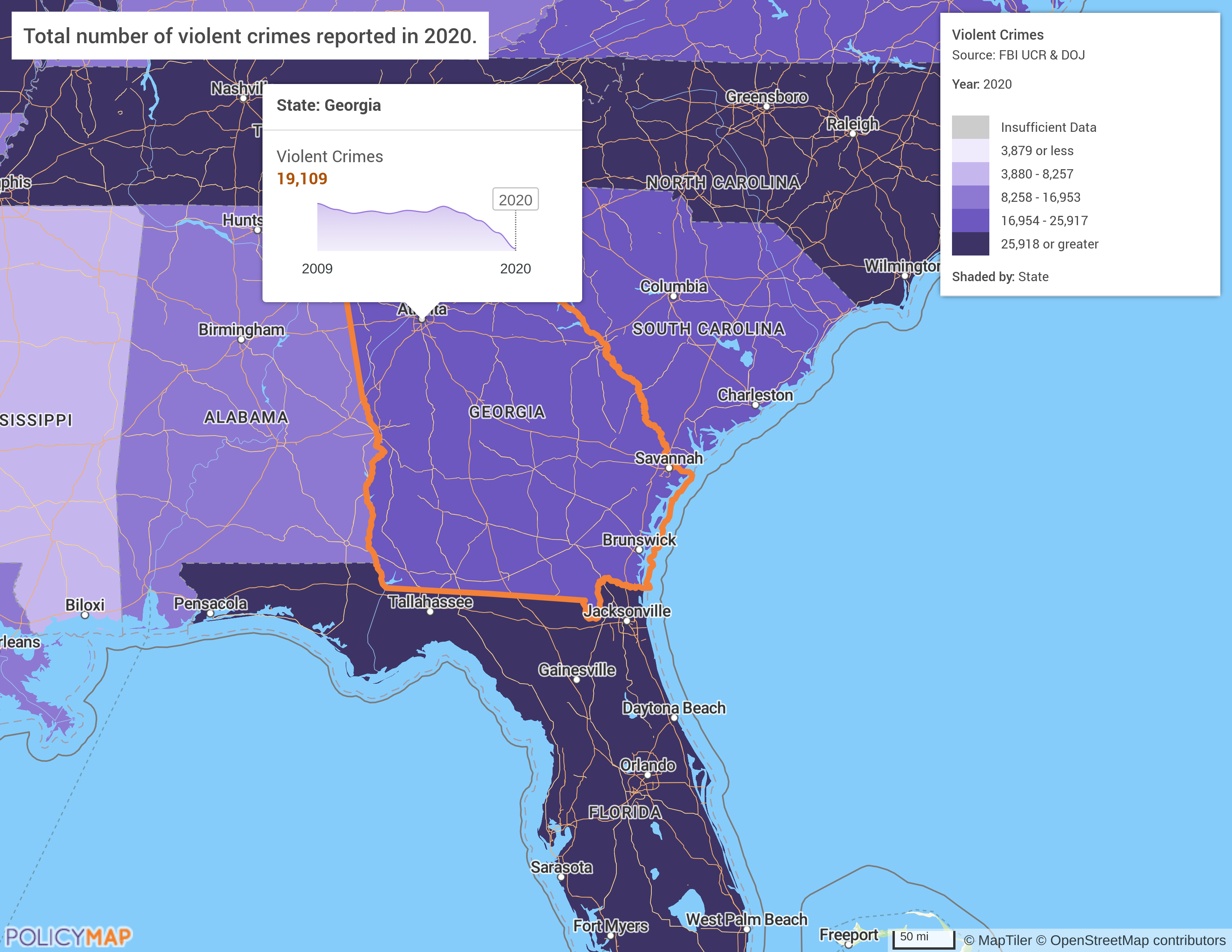Updates to FBI Property and Violent Crime Data

Data
FBI Uniform Crime Reports
Source
Federal Bureau of Investigation (FBI)
Find on PolicyMap
- Quality of Life
- Criminal Justice
Earlier this month, PolicyMap released an update to the Property and Violent Crime data from the FBI. Collected through the National Incident-Based Reporting System (NIBRS), the Uniform Crime Reporting (UCR) Program from the FBI compiles standardized incident reports from local law enforcement agencies to produce reliable, uniform, and national crime data. In the UCR Program, violent crime is composed of four offenses: murder and nonnegligent manslaughter, rape, robbery, and aggravated assault. Similarly, property crime includes the offenses of burglary, larceny-theft, and motor vehicle theft. This data is compiled in the UCR Program’s Crime in the United States (CIUS) report, which provides estimates on the volume and rate of these crimes. In this update, and going forward, PolicyMap will be using the estimates from this report as figures for crime data.
Change in Data Source
Previously, PolicyMap received city and county-level crime reports directly from the UCR program, which were compiled and then used to aggregate state-level data. PolicyMap published data through 2020 from these reports, after which the FBI stopped providing them. As PolicyMap had no other way of accessing this data, it was ultimately decided that the data source had to be changed.
After this, PolicyMap decided to transition this data to a public source, leading to the implementation of the UCR Program’s CIUS reports. While data in the CIUS reports is limited to state and MSA levels, these reports provide more accurate representations of crime as data is estimated for areas where agencies aren’t reporting. As stated in the FBI’s methodology, data is estimated as follows:
“The FBI computes estimates for participating agencies not providing 12 months of complete data. For agencies supplying 3 to 11 months of data, the national UCR Program estimates for the missing data by following a standard estimation procedure using the data provided by the agency. If an agency has supplied less than 3 months of data, the FBI computes estimates by using the known crime figures of similar areas within a state and assigning the same proportion of crime volumes to nonreporting agencies. The estimation process considers the following: population size covered by the agency; type of jurisdiction, e.g., police department versus sheriff’s office; and geographic location.”
As participation in the UCR Program is voluntary, not all police agencies across the country submit data to the FBI. PolicyMap’s original data was sourced directly from the UCR program’s reporting system, which only reflected agencies that had submitted data. Since the CIUS reports calculate estimates of crime for agencies not reporting data, some areas may see drastic changes to their crime levels, like in the pictures below.
Old 2020 Data

New 2020 Data

Current Data on PolicyMap
While PolicyMap was able to use the CIUS reports to add historical data through 2020 and 2022, the FBI did not provide crime estimates in the 2021 report. This was due to a change in reporting systems that led to exceptionally low data collection rates:
“On January 1, 2021, the FBI’s Uniform Crime Reporting (UCR) Program transitioned to a National Incident-Based Reporting System (NIBRS) only data collection. Since the transition, the FBI’s UCR Program has been working diligently to offer resources such as programming and technical support, training, and outreach to law enforcement agencies. Despite more than 11,500 law enforcement agencies submitting NIBRS data, participation for 2021 has remained below a statistically acceptable level to be nationally representative. To mitigate risks associated with low participation due to the NIBRS transition, the UCR Program will publish a limited release of the traditional CIUS, 2021, along with a trend study comparing 2020 and 2021 crime data using a selection of the new NIBRS estimation data.”
Therefore, crime data available to subscribers on PolicyMap is as follows:
- State: 2005-2020, 2020
- M.S.A: 2005-2020, 2020
- County: 2009-2020
- City: 2009-2020
PolicyMap encourages you to explore these updates and see how they enhance our crime data.
Request More Information
Crime data is an essential tool for communities, policymakers, and researchers seeking to understand and address the complexities of public safety. Ready to dig deeper? Fill in the form below to learn more or schedule a demo.